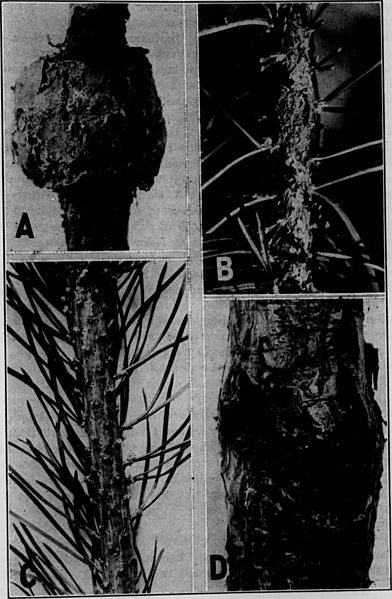Image: Contributions from the Botanical Laboratory, vol. 12 (1934) (20065769024)

Description: Title: Contributions from the Botanical Laboratory, vol. 12 Identifier: contributionsfro12univ (find matches) Year: 1934 (1930s) Authors: University of Pennsylvania. Botanical Laboratory; University of Pennsylvania. Morris Arboretum Subjects: Botany; Botany Publisher: Philadelphia : (s. n. ) Contributing Library: Penn State University Digitizing Sponsor: Lyrasis Members and Sloan Foundation View Book Page: Book Viewer About This Book: Catalog Entry View All Images: All Images From Book Click here to view book online to see this illustration in context in a browseable online version of this book. Text Appearing Before Image: li !i !i iMn-- 824 Phytopathology (Vol. 25 Microchemical tests. In connection with the histological study of sec- tions prepared by imbedding, a series of microchemical tests was made on sections freshly cut on the ether-freezing microtome. In most cases the tissues were sectioned a few minutes after they were removed from the tree. Starch, tannin, fats, resin, gums, cellulose, suberin, cutin, lignm, and pectin were identified by means of tests outlined by Eckerson^ or Stevens (34). r. a Physiological studies. Quantitative chemical analyses have been made of young twigs from both resistant and susceptible trees with regard to tannin, calcium, and potassium content. Analyses of various samples of soil collected at the base of both resistant and susceptible trees have been made with reference to the quantitative determination of calcium and potassium. Juices expressed from the twigs of resistant and susceptible trees by pulverizing the ground twigs with liquid air and subjecting this frozen mass to a pressure of 200 pounds per square inch for 10 minutes have been used for determination of osmotic pressure and hydrogen-ion concentration. An attempt has been made to reproduce in the resistant twigs the patho- logical changes found following infection. Extractives prepared from galls and from germinating spores were introduced into the tissues through small capillary tubes and also by hypodermic injection. Oxalic acid has been used in the same way, several investigators having reported a rela- tionship of this acid to the pathogenicity of fungi (5, 22). FIELD OBSERVATIONS OF HOST REACTIONS In their response to infection the inoculated trees have shown many different reactions ranging from highly susceptible to resistant. For the purposes of this discussion, however, 3 principal types of reaction may be distinguished. Type A occurs only in susceptible trees. During the first growing season there may be slight evidence of infection other than small brownish spots followed by minute swellings. The following spring, how- ever, marked hypertrophies develop and typical galls soon form (Fig. 2, A). In the reaction here designated as type B, there is often definite evidence of infection a few months after inoculation. Isolated discolored areas become confluent and for several inches along the twigs there will be reddish-brown discolorations. During the following growing season an excessive splitting of bark takes place on these twigs, sometimes accom- panied by a slight resinosis (Fig. 2, B). Occasionally a few abortive or atypical galls may develop from such areas. In type C reaction numerous small spots may be noted a few weeks after inoculation (Fig. 2, C). These are often greenish brown or slightly reddish in the center, sometimes sur- sEckerson, S. H. Microchemistry. University of Wisconsin. (Mimeographed). 1935) Hutchinson: Gall-forming Peridermium 825 4' I i 4 f Text Appearing After Image: Fig. 2. A. Twig of susceptible Scotch pine 3 years after inoculation showing gall typical of type A reaction. B. Partially resistant twig 1 year after inoculation showing cracked bark characteristic of type B reaction. C. Resistant twig 3 months after inocula- tion showing spotted areas commonly found in type C reaction. D. Resistant twig 3 years after inoculation showing exfoliation of bark often found in type C reaction. Photographs by H. H. York. Note About Images Please note that these images are extracted from scanned page images that may have been digitally enhanced for readability - coloration and appearance of these illustrations may not perfectly resemble the original work.
Title: Contributions from the Botanical Laboratory, vol. 12 (1934) (20065769024)
Credit: https://www.flickr.com/photos/internetarchivebookimages/20065769024/ Source book page: https://archive.org/stream/contributionsfro12univ/#page/n87/mode/1up
Author: University of Pennsylvania. Botanical Laboratory; University of Pennsylvania. Morris Arboretum
Permission: At the time of upload, the image license was automatically confirmed using the Flickr API. For more information see Flickr API detail.
Usage Terms: No known copyright restrictions
License: No restrictions
License Link: https://www.flickr.com/commons/usage/
Attribution Required?: No
Image usage
The following page links to this image:

